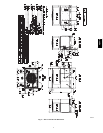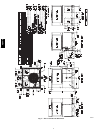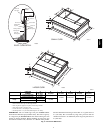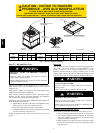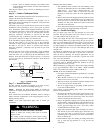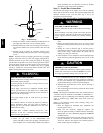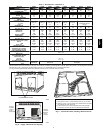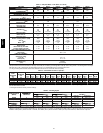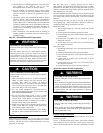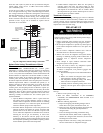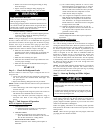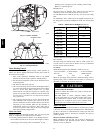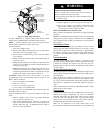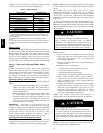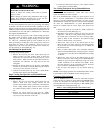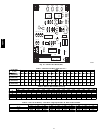
11
4. All units must ha ve field--supplied filters or accessory filter
rack installed in the return--air side of the unit.
Recommended sizes for filters are s hown in Table 1.
5. Size all ductwork for maximum required airflow (either
heating or cooling) for unit being installed. Avoid abrupt
duct size increases or decreases or performance may be
affected.
6. Adequately insulate and weatherproof all ductwork located
outdoors. Insulate ducts passing through unconditioned
space, and use vapor barrier in accordance w ith latest issue
of Sheet Metal and Air Conditioning Contractors National
Association (SMACNA) and Air Conditioning Contractors
of America (ACCA) minimum installation standards for
heating and air conditioning systems. Secure all ducts to
building structure.
7. Flash, weatherproof, and vibration--isolate all openings in
building structure in accordance w ith local codes and good
building practices.
Step 10 — Install Electrical Connections
ELECTRICAL SHOCK HAZARD
Failure to follow this warning could result in personal injury
or death.
The unit cabinet must have an uninterrupted, unbroken
electrical ground. This ground may consist of an electrical
wire connected to the unit ground screw in the control
compartment,orconduitapprovedforelectricalgroundwhen
installed in accordance with NEC, NFPA 70 National Fire
Protection Association (latest edition) (in Canada, Canadian
Electrical Code CSA C22.1) and local electrical codes.
!
WARNING
UNIT COMPONENT DAMAGE HAZARD
Failureto follow thiscaution may resultin damageto the unit
being i nstalled.
1. Make all electrical connections in accordance with NEC
NFPA 70 (latest edition) and local electrical codes
governing such wiring. In Canada, all electrical
connections must be in accordance with CSA standard
C22.1 Canadian Electrical Code Part 1 and applicable
local codes. Refer t o unit wiring diagram.
2. Use only copper conductor for connections between
field-- supplied electrical disconnect switch and unit. DO
NOT USE ALUMINUM WIRE.
3. Be sure that high-- voltage power to unit is within
operating voltage range indicated on unit rating plate. On
3--phase units, ensure phases are balanced within 2
percent. Consult local power company for correction of
improper voltage and/or phase imbalance.
4. Insulate low -- voltage wires for highest voltage contained
within conduit when low--voltage control wires are in
same conduit as high-- voltage wires.
5. Do not damage internal components when drilling
through any panel to mount electrical hardware, conduit,
etc.
!
CAUTION
High--Voltage Connections
When routing power leads into unit, use only copper wire between
disconnect and unit. The high voltage leads should be in a conduit
until they enter the duct panel; conduit termination at the duct
panel must be watertight.
The unit must have a separate electrical service with a
field-- supplied, waterproof disconnect switch mounted at, or within
sight from, the unit. Refer to the unit rating plate, NEC and l ocal
codes for maximum fuse/circuit breaker size and minimum circuit
amps (ampacity) for wire sizing.
The field-- supplied disconnect switch box may be mounted on the
unit over the high --voltage inlet hole when the standard power and
low--voltage entry points are used (See Fig. 2 and 3 for acceptable
location).
See unit wiring label (Fig. 15 and 16) and Fig. 10 for reference
when making high voltage connections. Proceed as follows to
complete the high--voltage connections to the unit.
Single phase units:
1. Run the high-- voltage (L1, L2) and ground lead into the
control box.
2. Connect ground lead to chassis ground connection.
3. Locate the black and yellow wires connected to the line side
of the contactor.
4. Connect field L1 to black wire on connection 11 of the
compressor contactor .
5.ConnectfieldwireL2toyellowwireonconnection23of
the compressor contactor.
Three--phase units:
1. Run the high -- voltage (L1, L2, L3) and ground lead into the
control box.
2. Connect ground lead to chassis ground connection.
3. Locate the black and yellow wires connected to the line side
of the contactor.
4. Connect field L1 to black wire on connection 11 of the
compressor contactor .
5.ConnectfieldwireL3toyellowwireonconnection13of
the compressor contactor.
6. Connect field wire L2 to blue wire from compressor.
Special Procedures for 208--V Operation
ELECTRICAL SHOCK HAZARD
Failure to follow this warning could result in personal injury
or death.
MakesurethepowersupplytotheunitisswitchedOFFbefore
makinganywiring changes.Tagthedisconnectswitchwitha
suitable warning label. With disconnect switch open, move
black wirefromtransformer(3/16 in.)terminalmarked 230 to
terminal marked 200. This retaps transformer to primary
voltage of 208 vac.
!
WARNING
ELECTRICAL SHOCK HAZARD
Failure to follow this warning could result in personal injury
or death.
Beforemakinganywiringchanges,makesurethegassupply
is switched of f first. Then switch off the power supply to the
unit and install lockout tag.
!
WARNING
Control Voltage Connections
Do not use any type of power-- stealing thermostat. Unit control
problems may result.
Use no. 18 American Wire Gage (AWG) color-- coded, insulated
(35_C minimum) wires to make the control voltage connections
between the thermostat and the unit. If the thermostat is located
48VT--A



